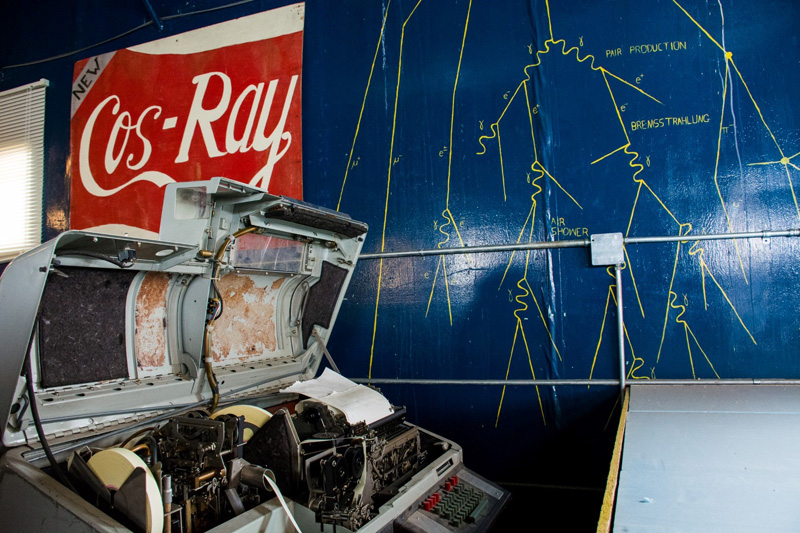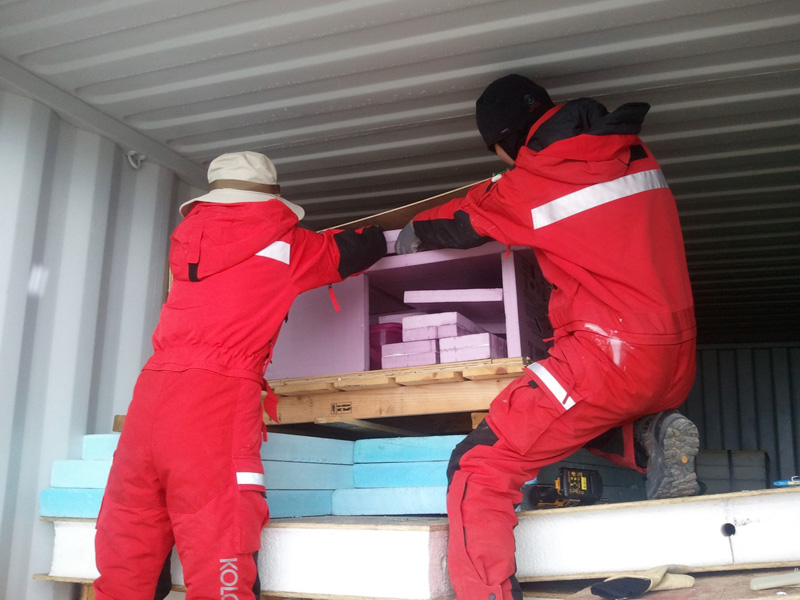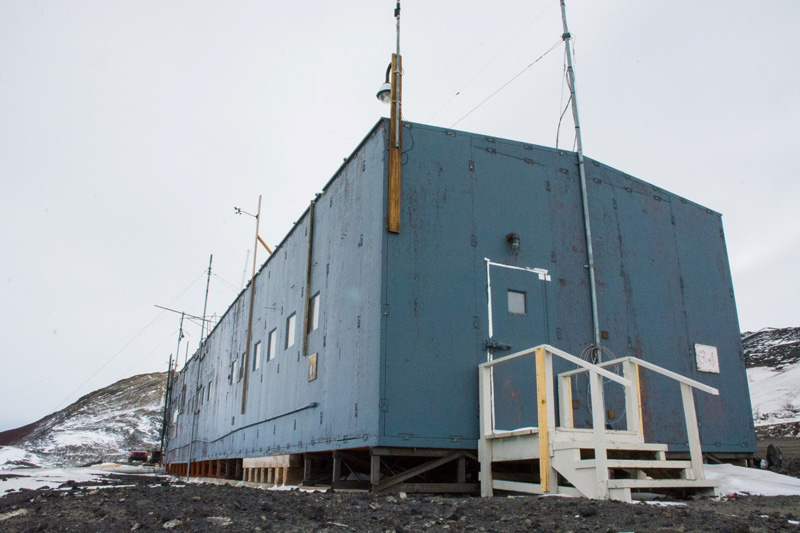A New Home for an Old ExperimentPosted February 9, 2016
The longest running experiment at McMurdo is leaving the station, but it’s not moving too far away, Antarctically speaking. 
Photo Credit: Michael Lucibella
A mural depicting an air shower from a cosmic ray adorns the wall behind an old ticker tape readout unit next to the CosRay detectors. The experiment is the longest continually running experiment at McMurdo Station.
The CosRay experiment, which has been recording changes in the stream of cosmic rays striking Earth since 1960, is relocating to the new South Korean station, Jang Bogo, about 230 miles away. It’s one of the closest stations to McMurdo, but because of Antarctica’s untamed nature, it’s a four-year project to move everything. “If there was a road we probably could have moved it easily in a few days,” said James Madsen of the University of Wisconsin-River Falls, who is in charge of packing the equipment at McMurdo. The project’s principle investigator, Paul Evenson, traveled to the South Korean station this year to assist with the installation. The research is supported by the National Science Foundation, which manages the U.S. Antarctic Program. They’re transferring the experiment in segments in order to preserve its ability to record consistent data. The first section of six long detector tubes and ten tons of lead shielding arrived at Jang Bogo in December and is now operating. The remaining two segments will keep running in McMurdo until the 2016-2017 season. “By collecting data simultaneously for a year, we’ll be able to ensure that everything is performing as expected,” Madsen said. If everything checks out after the end of the shakedown period, Madsen will return to McMurdo next year to pack up and ship out the remaining two sections to Christchurch, New Zealand. After a winter in storage, the detectors will be transported to Hobart, Australia, where the Koreans will pick them up and install them alongside the ones now at Jang Bogo. 
Photo Credit: Michael Lucibella
A counter at the end of one of the CosRay detector tubes registers neutrons from cosmic rays.
The plan to relocate the experiment resulted from a confluence of a number of common interests. Located along Terra Nova Bay, the new South Korean station first started operating in 2014, and its planners wanted to include a similar experiment on their scientific slate from the start. At the same time, supporting the experiment at McMurdo was growing more challenging. Scientists first switched on the experiment 56 years ago and it’s been taking data continuously ever since. The building that’s housed the experiment for almost its entire life is now in need of significant renovation, and the researchers overseeing it are preparing to move on, or have commitments split between that and other projects. Evenson, from the Bartol Research Institute at the University of Delaware, has been with the project since its founder Martin Pomerantz retired in 1989. He led the project along with John Bieber until Bieber left in 2012. “I’m only a couple of years from retirement… and so the issue of exactly what the continuity would be down there would be problematic,” Evenson said. He added that transferring it to the South Korean station “saves the hassle of relocating it at McMurdo, and also solves the problem of who is going to maintain it.” Madsen has been working with the project for about three years, but is primarily involved with the AMANDA and IceCube neutrino detectors at the South Pole. “The bottom line is my interest is more along the IceCube side of things,” Madsen said. 
Photo Credit: Paul Evenson
Workers at the Korean Station Jang Bogo unload components to the CosRay experiment after being shipped to their station from winter storage in Australia.
The CosRay experiment studies the magnetic field of the sun by measuring incoming subatomic particles from deep space known as cosmic rays. Every second of every day, Earth is barraged by a constant stream of energetic particles moving at the speed of light. Roughly ten pass through an average person every second. They’re anachronistically still called “rays,” though researchers have long known what they’re reading are actually charged particles like protons, electrons and ions. Predominantly produced by distant supernovae and other poorly understood interstellar phenomena, cosmic rays bombard the planet from all sides. Although CosRay is set up to measure these cosmic rays from deep space, it’s the magnetic field of Earth’s own stellar neighbor, the sun, that’s the focus of the team’s research. They’re looking at how the field changes by watching how well it deflects these cosmic ray particles. “The flux of these particles would basically be a constant except for the magnetic activity of the sun,” Evenson said. The sun’s magnetic field is enormous, engulfing all of the planets and extending out into interstellar space. It’s also constantly changing whenever a solar flare erupts or its surface darkens from a sunspot. “That’s all a result of the magnetic activity of the sun,” Evenson said. “Understanding the short term behavior of the sun is equivalent to understanding the magnetic activity on the sun.” When these stellar events alter the sun’s magnetic field, the number of cosmic rays striking Earth’s surface vary accordingly. Like a Geiger counter, the detectors count whenever a high energy neutron passes through one of their detection tubes. “Our detectors mostly just give us a rate, a number per second,” Madsen said. “The change will occur over a few tens of seconds, and may last couple of tens of hours.” The neutrons picked up by the detectors aren’t the cosmic rays themselves, they’re the remains left over from them bombarding their way through the atmosphere. When a high energy cosmic ray enters the atmosphere, it soon strikes an air molecule which shatters. The fragments of that molecule then smash more molecules, creating a downward cascade of particles known as an “air shower.” “The ground level detector is measuring the secondary debris from cosmic rays,” Evenson said. If the sun’s magnetic field gets twisted enough, it can send its own torrent of high energy particles blasting out into space. Solar flares and coronal mass ejections can happen with little notice and send a storm of charged particles towards Earth if it’s caught in the way. These storms can wreak havoc on satellites, earthbound communications systems and even some sensitive electronics. In the past, solar bombardment has been so bad that commercial flights over the North Pole have been canceled. 
Photo Credit: Michael Lucibella
The CosRay building sits atop the pass between McMurdo Station and New Zealand's Scott Base.
“Those very high energy solar storms can damage electronics,” Madsen said. “The [sun’s] mechanism that produces those high energy particles, and the spectrum of those high energy particles, is not well understood.” The neutron counter at McMurdo is part of a web of similar detectors located at high latitudes around the world. Together, they make up the Spaceship Earth network, which provides scientists a continuous, three-dimensional look at the intensity of cosmic rays striking the atmosphere. The relocation to the South Korean station is not the first time the experiment has been moved, but it the farthest distance it’s traveled. When it was first built, the detectors were located in downtown McMurdo. When in the early 1960s, when a small nuclear power plant was installed on Observation Hill overlooking the station, the experiment was moved to the hill’s far side to further shield it from the neutrons emitted by the reactor. This move to the new station shouldn’t affect the experiment’s ability to collect data. Though Jang Bogo is farther away from the geographic South Pole than McMurdo, it’s marginally closer to the magnetic pole, where the Earth’s magnetic field extends straight out from its surface. “Korean station is essentially equivalent in terms of location,” Evenson said. “If we do it right, the world will really never know the difference.” NSF-funded research in this article: Paul Evenson, University of Delaware, Award No. 1245939 |



For USAP Participants |
For The Public |
For Researchers and EducatorsContact UsU.S. National Science FoundationOffice of Polar Programs Geosciences Directorate 2415 Eisenhower Avenue, Suite W7100 Alexandria, VA 22314 Sign up for the NSF Office of Polar Programs newsletter and events. Feedback Form |


